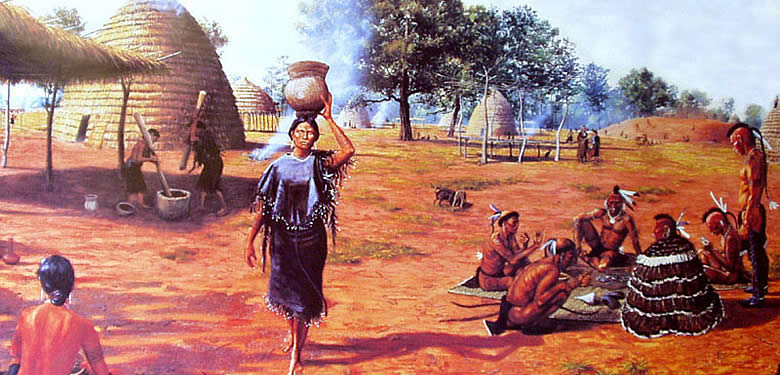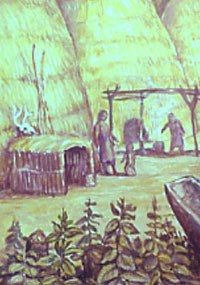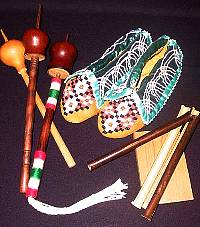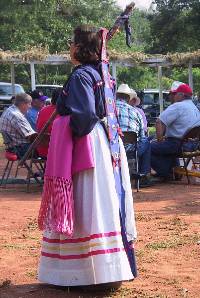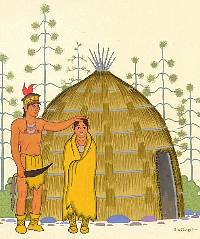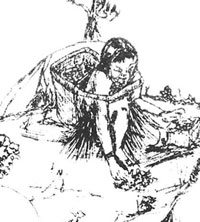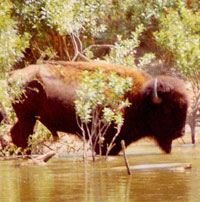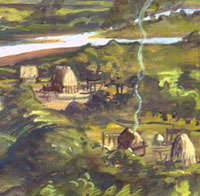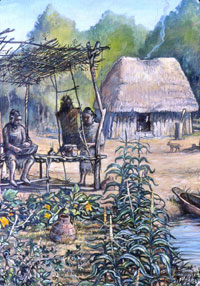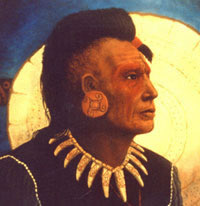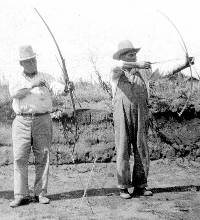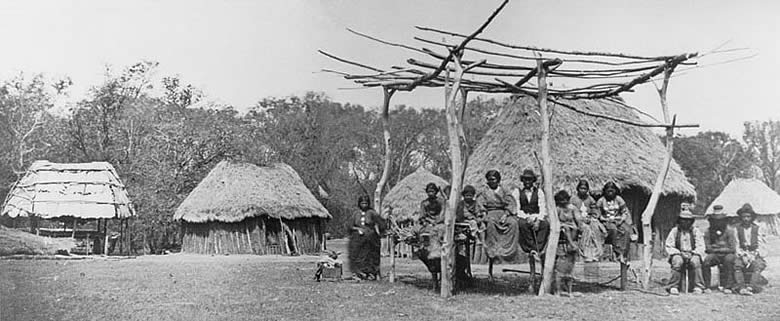"Among the seed
which the Indians plant at the proper season, is corn
of two kinds, which they plant in abundance. One kind
matures in a month and a half and the other in three months."
-Spanish priest Fray Casañas, 1691. |
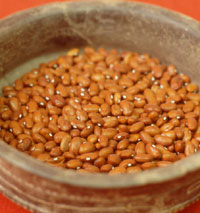
Dried beans in an ancient Caddo bowl.
The Caddo grew five or six varieties of beans according
to Fray Casaņas, a Spanish priest who lived among the
Hasinai Caddo in 1691. Photo by Frank Schambach.
|
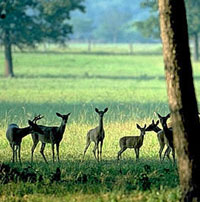
White-tailed deer were the favored
prey for Caddo hunters and the main source of meat throughout
Caddo history. Deer hunts were preceded by special ceremonies
involving deer heads and skins. Courtesy Texas Parks
and Wildlife Department.
|
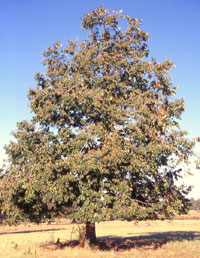
The American persimmon tree, Diospyros
virginiana, grows in much of the Eastern United States
including the Caddo Homeland. Its astringent fruit ripens
in the fall and becomes sweet and quite delicious when
fully ripe and after the first frost. Photograph by
Frank Schambach.
|
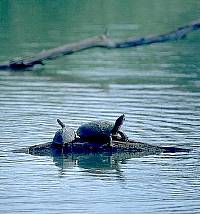
Soft-shelled turtles and other aquatic
critters and fish were part of the diet of those Caddos
lived near rivers and larger streams. Courtesy Texas
Parks and Wildlife.
|
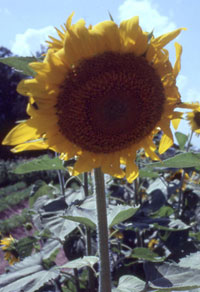
Sunflowers were an important seed
crop and one of the plants domesticated in the Eastern
United states. Early Spanish explorers were surprised
by the size of the giant sunflower heads the Caddo grew.
Photograph by Frank Schambach.
|
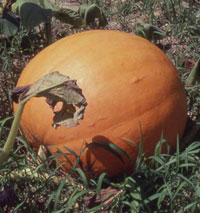
Pumpkins were grown and savored by
the Caddo and their Wichita cousins. Like their close
relative, the winter squash, pumpkins were cut into
strips and dried. The strips were woven into crude mats
for easy transportation and storage. Photograph by Frank
Schambach.
|
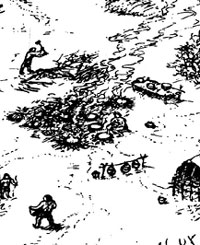
Artist Ed Martin's depiction of salt-making
scene based on historic accounts and archeological evidence
from the Ouachita Valley in Arkansas. Caddo groups who
lived near natural seeps of highly salty water called
salines collected the salt by evaporating the water.
In 1700, French explorers encountered Ouachita Caddos
paddling canoes laden with salt on the lower Red River
on their way to trade with the Taensa people living
in the lower Mississppi Valley. Courtesy Arkansas Archeological
Survey.
|
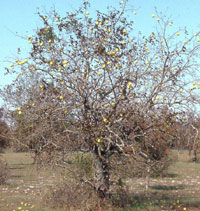
Bois d'arc or Osage orange tree in
late fall. Its fruits are inedible to humans and most
animals but horses love them, hence the name "horse
apple." According to evolutionary biologists, only
a small relic population of Bois d'arc trees survived
after the end of the last Ice Age. The tree does not
compete well with other trees and it needs large herbivores
like horses or mammoths to spread the seeds. When Europeans
reintroduced horses to North America in the 16th century,
the tree spread quickly aided by farming practices.
Photograph by Frank Schambach.
|
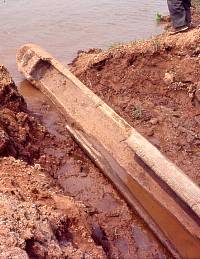
This Caddo dugout canoe was found
washing out of the base of a steep bluff on the Red
River in northwest Louisiana. It has been radiocarbon
dated to about A.D. 1000. Photo by Frank Schambach.
|
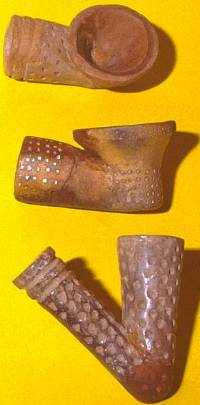
Late Caddo ceramic pipe bowls from
the A.C. Saunders site in northeast Texas. Wooden or
bone stems were added to such pipe bowls. Tobacco was
grown by the Caddo and was used in both ritual and ordinary
settings. The Caddo greeted early Spanish and French
visitors with the calumet or smoking-pipe ceremony as
was common among many Southeast and Plains groups. TARL
archives.
|
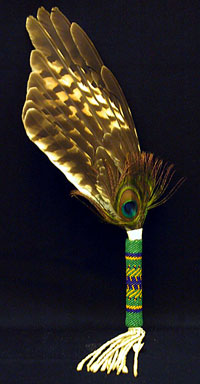
This hawk wing and peacock feather
dance fan is a modern example of a very old Caddo tradition—the
making of ritual and dance paraphernalia. Maker unknown,
c. 1970, in the Claude Medford, Jr., Collection., Williamson
Museum, Northwestern State University, Nachitoches.
Photo by Dayna Bowker Lee.
|
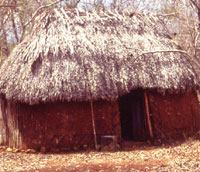
This thatched hut in the Yucatan
of Mexico was constructed using traditional techniques
very similar to those used by Caddo groups in the northern
Caddo Homeland. Photo by Frank Schambach.
|
|
Caddo Economy
The first Spanish and French visitors to the
Caddo Homeland encountered thriving communities whose livelihood
was based on farming, hunting, gathering, and trade. Archeological
evidence indicates that a mixed economy was characteristic
of Caddo ancestors for at least a thousand years, probably
much longer. Most accounts of Caddo life emphasize agriculture
and rightly so because farming provided much of the dependable
food supply upon which village life depended. The central
role played by farming also helps explain why Caddo settlements
characteristically were scattered and spread out—the
Caddo lived among their fields and gardens.
In historic times, corn (also called
maize) was the mainstay crop. The Caddo grew several varieties
of corn including "little" corn that ripened in
the summer and "flour" or "great" corn
that ripened in the fall. Corn was dried on the cob and stored
in raised granaries to keep it dry and protected from rodents.
The Spanish noticed that the Caddo always saved their best
corn for seed and hung the seed corn cobs high inside their
houses where it would not be touched except for planting,
no matter how little food was available. Corn also figured
prominently in the annual ritual cycle with planting ceremonies,
first-fruit or green corn ceremonies, and harvest rites. Successful
fall harvests occasioned major festivals at the principal
villages. These drew kinfolk and allies near and far for several-day
celebration of Caddo life: feasting, tobacco-smoking, black-tea-drinking,
dancing, trading, negotiating, courtship, and more.
Other important crops included beans (five or
six varieties according to Fray Casañas, the Spanish
priest who lived among the Hasinai in 1691), squash, pumpkins,
sunflowers, and various lesser-known domesticated plants including
goosefoot (Chenopodium sp.). The Caddo quickly adopted crops
introduced by the Europeans, including watermelon and peaches.
Tobacco was another important crop required for ritual use.
Women did most of the farming and all of the food preparation,
although men did some heavy work such as clearing fields and
helped at critical times such as harvest. Farming was also
very much a communal activity. Fields were owned by the community
and families were assigned specific plots by the tammas. Planting
and harvesting were community projects that moved from plot
to plot beginning with that of the xinesi and moving down
the social ladder until each family plot had been reached.
Wild plants, game, and fish were also vital
food resources. Wild plants included nuts (hickory, walnut,
acorn, and pecan), berries, plums, persimmon, grapes, and
various seed plants, just to name a few. Throughout most of
Caddo history, the favorite game animal hunted by Caddo men
was the white-tailed deer. Deer provided most of the
meat as well as hides, antlers, sinew, and bones for tools
and clothing. Deer also figured prominently in Caddo dance
and symbolism. Buffalo were hunted on extended trips west
or northwest out onto the prairie-plains, but were not an
important food source until after the late 17th century after
the Caddo acquired horses. Turkeys, rabbits, and various other
small animals and birds were hunted and snared. Caddo living
along productive waters caught fish, turtles, and other aquatic
species. Bear were hunted for food, fur, and especially for
their fat, which served many useful purposes and was traded
to the French.
Three factors seem to underlie the long-term
success of the Caddo economy: diverse natural resources,
well-developed food processing and storage technologies, and
the ready adoption of new crops from their neighbors and
trading partners. Caddo peoples relied on many different wild
and cultivated food resources, of which only a few have been
mentioned. These changed in importance from place to place
and with the seasons, the vagaries of rainfall, and through
time. When crops failed, the Caddo turned to wild plant foods
that had been used for generations.
They had many ways of storing food to
get them through the annual low point in resource availability:
winter and early spring. They dried corn, beans, pumpkins,
wild fruits, and deer meat. They smoked fish and other meats.
They built raised and tightly sealed granaries to keep their
corn supplies dry and vermin-free. Along the Red River west
of the Great Bend, some Caddo groups used underground storage
pits similar to those used by their Plains neighbors. From
river cane and certain barks and grasses, Caddo women wove
baskets and trays large and small, tight or loose; some for
storage, others for winnowing and sieving. Out of clay they
created all manner of ceramic cooking, storage, and serving
containers. Bear fat, for instance, was rendered and stored
in clay pots. Through such methods the Caddo survived thick
times and thin.
Agriculture was central to Caddo life when Caddo
communities were first visited by Europeans, but this was not
always the case. Early Caddo ancestors were hunters, gatherers,
and fishers, living off the land. By 2,000 years ago,
if not well before, ancestral Caddo groups began to cultivate
the starchy and oily seeded plants that had been domesticated
in the Eastern Woodlands by about 2000 B.C. We aren't certain
when this happened because few plant remains of any sort have
been recovered from the excavated Woodland sites in the Caddo
Homeland. But there is little reason to doubt that native
crops, including goosefoot, marsh elder, squash, and possibly
sunflower, were adopted early on by the Caddo.
At first these native seed plants would have
been mere supplements to hunting and gathering, but along
with gardening comes the requirement of returning to fixed
places to plant, harvest, process, and store. The native seed
crops were probably sown broadly in minimally cleared plots
and allowed to compete with weeds. The real labor was in the
harvest and processing; only the sunflower had compact durable
seed heads. Goosefoot and marsh elder had small seeds and
friable seed heads. All had to be carefully cleaned and separated
from the stalks and chaff. These native seeds tasted bland
and were probably prepared mainly in stews and gruels. Gradually,
farming became more important, but was probably still secondary
to hunting and gathering for centuries. Even though early
farming must have provided only a small, labor-intensive part
of the diet, the ability to produce this extra food and the
requirement to stay nearby while it grew may have been the
critical factors that led to increasingly settled village
life.
Later, we aren't sure exactly when, the Caddo
adopted a tropical plant that had been domesticated in Mesoamerica
and already adopted by farming peoples in the American Southwest:
corn. Corn first appears at Caddo sites around A.D. 800,
but may not have become a mainstay of the economies of most
groups until after A.D. 1100. The reason for this lag is unknown,
but a similar pattern occurred elsewhere in the Southeast,
including the lower Mississippi valley. By 800 years ago (A.D.
1200), the Caddo were big-time corn farmers who also grew
squash/pumpkins, beans, sunflowers, and various other crops.
Corn had to be planted seed by seed in individual
holes and required greater effort to clear the land, keep
it weeded, and fend off animals and birds. But the payoff
came at harvest time when whole stalks could be broken off
and gathered quickly, each containing one or two fat seed
heads (cobs). (Corn was harvested stalks and all because the
stalks were useful fuel for cooking fires.) Compared to the
native seed crops, corn required minimal cleaning and processing
and, once dried, could be readily stored without husking or
stripping.
Perhaps even more important was the fact that
corn tasted sweet and flavorful, and it could be prepared
in many more ways than the native crops: raw, parched, roasted,
steamed, boiled, ground into flour, and more. Small wonder
that corn became the economic lynchpin of Caddo life, celebrated
in song and ritual, and symbolically linked to the sun,
the giver of life. There was a downside; eating lots of corn
caused a noticeable increase in caries (cavities).
Trade was also an important part of the
Caddo economy, at least in historic times. Caddo groups traded
resources found within the Caddo Homeland among each other
and to outside groups. The best-known Caddo trade goods were
bois d'arc wood and salt. Salt was obtained in various places
in the Caddo Homeland where saltwater springs or seeps were
present. Caddo salt workers concentrated the salt brine by
evaporation and boiling in heavy pottery pans and then traded
the dried salt to groups elsewhere. For instance, in the spring
of 1700, French explorers encountered Ouachita Caddos paddling
canoes laden with salt along lower Red River, on their way
to trade with Taensa peoples living along the Mississippi.
Bois d'arc (Osage orange) bow wood blanks and
finished bows from the Caddo Homeland were traded for hundreds
of miles east and west. Bois d'arc is the best bow wood
found east of the Rockies and the Cadohadacho groups may
have had a monopoly on it. By late prehistoric times the natural
range of bois d'arc apparently was restricted mainly to a
small area along and south of Red River valley, just upstream
from Texarkana.
Bois d'arc does not grow well among other trees
and evolved to rely on large herbivores like horses or mammoths
to spread its seeds to open areas; most other species, including
humans, find the horse apple, as its fruit is known, inedible.
At the end of the last Ice Age about 12,000 years ago, horses
and mammoths became extinct in North America, leaving the
bois d'arc without a natural means of spreading. By the time
Europeans arrived, the main remnant bois d'arc population
grew within the western Caddo Homeland at the edge of the
Blackland Prairie. The reintroduction of horses and Anglo-American
farming practices allowed the bois d'arc to spread quickly
over a wide area of the south-central U.S. Farmers planted
bois d'arc along fence rows, were it is still principally
found today.
The role of the bow-wood trade in Caddo history
has recently become the subject of debate. Arkansas
archeologist Frank Schambach has put forth the intriguing
argument that, prior to the historic period, the bow-wood
trade was controlled by Mississippian traders (ancestral Tunica)
from Spiro who established trading posts within the Caddo
Homeland. The idea that foreign, non-Caddo intruders controlled
enclaves within Caddo territory, such as the Sanders site
on the Red River in Lamar County, has not been accepted by
many Caddo scholars (nor by the Caddo Nation). For instance,
the state archeologists of both Arkansas (Ann Early) and Oklahoma
(Robert Brooks) have taken issue with Schambach's argument.
This controversial interpretation and arguments pro and con
will be the subject of a future exhibit on Texas Beyond
History.
Regardless of who controlled the bow-wood trade,
trade may well have played a greater role in Caddo history
than has been recognized. The Caddo Homeland is, after
all, located between the Southeast and the Plains as well
as the Southwest, three major culture areas and ecological
zones with very different natural resources. Dried buffalo
meat and buffalo hides from the Plains were traded widely
in early historic times, as were salt, bow wood, and artifacts
made of Gulf of Mexico shells from the Southeast, as well
as cotton, turquoise, and shell artifacts from the Gulf of
California from the Southwest. The spectacular wealth entombed
in the Craig Mound at Spiro (about A.D. 1350-1450) is almost
certainly a product of an earlier east-west trade system and
there are many reasons to suspect that the Caddo groups to
the south were also major players, particularly in the centuries
following the demise of Spiro as a major center. In the early
18th century, the French quickly enlisted the Caddo as trading
partners to take advantage of their strategic position and
established reputation as trustworthy middlemen.
Caddo Ritual and Religion
In the late 17th century the Hasinai were said
to believe in a supreme god called the Caddi Ayo or
Ayo-Caddi-Aymay, sometimes translated as "captain
of the sky." The Caddi Ayo was believed to be the creator
of all things and was held in great deference. The natural
world of the Caddo was, however, inhabited by many other kinds
of spirits including those personified by animals, places,
and forces of nature. The Caddo followed many ritual practices
in order to keep things right in their world. Matters religious
were organized in a hierarchal fashion parallel to those that
ordered society.
The xinesi or head priest lived in a
special precinct within the Hainai (chief Hasinai group) community
or, after the early 1700s, in a separate place between the
Neche and Hainai communities. Either way, the xinesi lived
in a large grass-thatched house that stood near the fire temple,
the principal Hasinai temple within which burned a perpetual
fire fed by four logs, each oriented on a cardinal direction.
Among the xinesi's chief responsibilities was keeping the
fire going. There were apparently other, lesser fire temples
among the Hainai groups, watched over by lesser priests or
by the caddis. Similar temples were also described among the
Cadohadacho and, archeological evidences suggests this was
a widespread and old Caddo practice.
The Hasinai fire temple was a very large
structure that also served as a council house where important
matters were decided. Nearby was one or two small houses where
two divine boys (possibly twins) called the coninisí
lived. These children served as intermediaries between the
xinesi and the Caddi Ayo and were only visible to the xinesi,
a circumstance that the Spanish priests ridiculed and cited
as proof of the false nature of Caddo religion. Nonetheless,
belief in the coninisi was widespread and they are may be
analogous to the hero twins found in many other Native American
religions.
The xinesi was aided by other priests or shamans,
some of whom carried out similar duties for individual communities
and some of whom had specialized assignments. While most priests
were men, there were apparently some women as well. The Spanish
accounts are not clear on how the Caddo priesthood was organized,
in part because priests on both sides saw the others, quite
correctly, as dangerous competitors who challenged their own
domains.
Caddo life was seen as dependent on the proper
performance of rituals small and large for continued success.
There were proper and wrong ways of doing all things of substance.
For instance, hunters sought a priest on the eve of a deer
hunt to perform elaborate rituals involving the head and horns
of a deer. If successful, the deer could not be butchered
and eaten until a priest had whispered into its ear and taken
the first share of meat. Similarly important rituals were
associated with agriculture. Young and old women took part
in a special spring ritual prior to planting to ensure good
crops. There were also first fruit or green corn ceremonies
and harvest ceremonies, each being the occasion for feasting
as well as ritual.
The connas, the Caddo medicine men or
healers, were said to use herbs and various ritual practices
such as smoking, sweating, incantations, and divination to
cure sickness and heal the wounded. While the Spanish were
distrustful of the medicine men, they also observed successful
healing and realized that some of the herbal remedies were
potent. Many of the curing ceremonies involved practices the
Spanish associated with the devil. The Spanish priest Espinosa
as translated by Bolton describes one such event.
To cure a patient they make a large fire
[under the bed] and "provide flutes and a feather fan.
The instruments [palillos] are manufactured [sticks] with
notches resembling a snake's rattle. This palillo [rasp]
placed in a hollow bone upon a skin makes a noise nothing
less than devilish. Before touching it they drink their
herbs boiled and covered with much foam and begin to perform
their dance without moving from one spot, accompanied by
the music of Infierno, or song of the damned, for only in
Inferno will the discordant gibberish which the quack sets
up find its like. This ceremony lasts from midafternoon
to nearly sunrise. The quack interpolates his song by applying
his cruel medicaments.
It is unlikely that the medical practices of
17th century Europe would be viewed by us today as any more
sound or less superstitious than that of the 17th century
Caddo. The Spanish and French witnessed and sometimes harshly
described a Caddo society that had a complex and quite sophisticated
set of beliefs and practices about the natural and supernatural
world. It is only to be expected that the two worlds were
foreign to one another and that neither side really understood
the other.
|
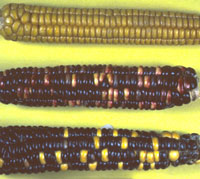
Heirloom varieties of "Indian
corn" thought to be similar to those grown by Caddo
ancestors. The top ear is 7.5 inches long (19 centimeters).
Photograph from Richard I. Ford, courtesy Dee Ann Story.
|
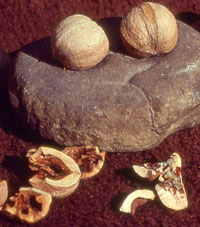
Hickory nuts were an important food
throughout Caddo history and probably long before. These
tough-shelled nuts were high in fat and protein, but
difficult to shell. Pitted "nutting" stones,
such as those shown here, are found in Archaic, Woodland,
and Caddo sites. Photograph by Frank Schambach.
|
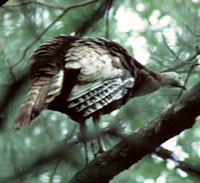
Wild turkey in piney woods of southeastern
Arkansas. Turkeys were hunted for their meat and feathers.
The turkey also inspired the famous Turkey Dance, a
Caddo favorite. Photo by Bill Martin.
|
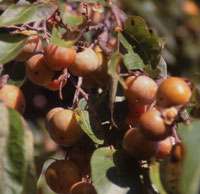
Ripe American persimmons were a fall
treat for the Caddo and were used in a variety of ways.
In early fall, persimmons are very astringent, causing
the mouth to pucker. But when fully ripe and after the
first freeze they become sweet and tasty. Dried persimmons
could be stored for months. Photograph by Frank Schambach.
|
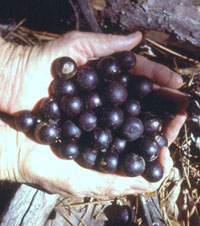
Muscadine grapes grow plentifully
in much of the Caddo homeland. Although very tart, they
could be gathered in large quantities in late summer.
Photograph by Frank Schambach.
|
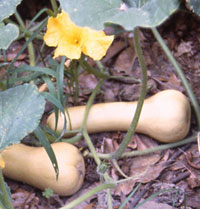
Winter squash similar to this butternut
squash was a favorite Caddo crop. The thick-fleshed
squash could be cut into strips and dried, similar to
pumpkins. Photograph by Frank Schambach.
|
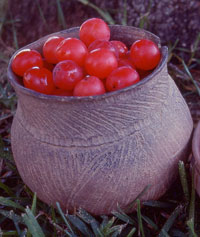
Wild plums (Prunas sp.) were a seasonal
delight for the Caddo. These tart but nutrious fruits
could be harvested in large quantities in late spring
during good years when rains came at the right times.
Some were eaten fresh, but most were mixed with other
foods, such as stews and pemmican, or dried for later
use. Photo by Frank Schambach.
|
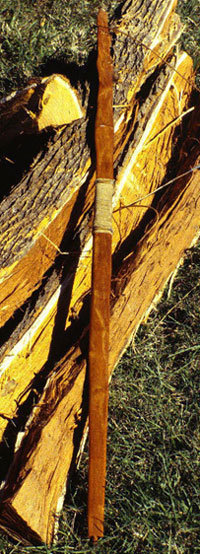
Bois d'arc wood, one of the best
bow-making woods in North America, was traded far and
wide from its only source, a small area of the Caddo
Homeland near the Red River above the Great Bend. Photograph
by Frank Schambach.
|
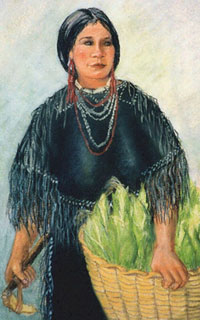
Artist Reeda Peel's depiction of
a Caddo woman carrying a basket of freshly picked corn.
Corn became the Caddo's mainstay crop about 800 years
ago and was considered a sacred plant because of its
importance to Caddo life. Courtesy of the artist.
|
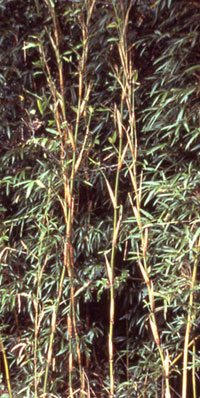
Native river cane once grew profusely
along streams and rivers in the Caddo Homeland. Today
it has largely been replaced by an exotic species of
Asian cane. Cane was put to many uses including house
building and for weaving. The Caddo were famous for
their split cane mats and baskets. Photograph by Elizabeth
Stoker, courtesy Frank Schambach.
|
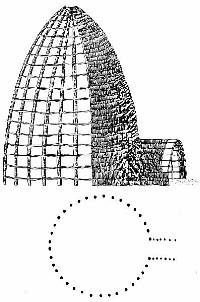
In the southern Caddo Homeland, tall
grass-thatched houses with circular outlines were the
most common form. Extended entranceways, as shown in
this diagram, were often associated with larger buildings
thought to be the residences of important people. Courtesy
Frank Schambach.
|
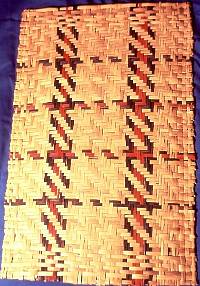
This split-cane mat, made by the
late Claude Medford, Jr. (Choctaw), is probably very
similar to those for which the Caddo were well known.
Courtesy Frank Schambach.
|
|
